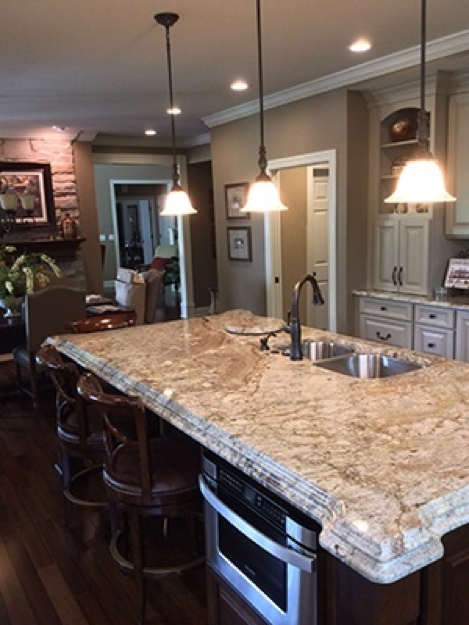
Choosing a right edge profile for your new granite or quartz countertops is one of the important steps during your shopping process. Here are the three criteria that you can follow for a great outcome for your stone countertops project.
In the “old days,” we had to fabricate all our granite edges completely by hand (go back a bit farther and we had to polish all the surfaces by hand as well).
Nowadays, thanks to CNC machines and other upgrades, a modern fabrication shop like Arch City Granite can combine custom craftsmanship and technological innovation. For our clients, this means a huge variety of edge types from which to choose.
You can see a full list of available edges here. In this post, we’ll lay out three basic criteria to keep in mind when selecting the edge “profile” for your granite project. The criteria are: Style, Material, and Design Context.
First, let’s quickly go over the basic types of granite edges. The simplest edge available is the Eased Edge, which is just polished with a tiny bit of rounding on the edges, so that it is not sharp.
If you want a bit more detail, check out these edges: Top and Bottom Rounded Edge, 1/4 in. Beveled Edge, 1/2 in. Beveled Edge, Roman Round Edge, Half Round Edge (also called Half Bullnose), and Full Bullnose Edge.
For an edge with a lot of character, take a look at the Ogee Edge, Elite Edge, and Roman Elite Edges.
Last, but certainly not least, are Laminated Edges. Don’t get confused by the name, the word “laminated” here refers to the process by which we affix an extra piece of stone beneath the edge of the granite to make the edge look like it is 6cm (2 1/2 in.) thick instead of the standard 3cm (1 1/4 in.).
Laminated Edges can be as simple as a 6cm Eased Edge or as ornate as an Ogee over Ogee Laminated Edge.
Criteria #1: Style
The first criteria for selecting a granite or marble edge profile should be your own personal tastes and style. It doesn’t matter how well an edge may or may not go with a stone or the space if you don’t love it.
Start by looking at samples of edges and letting yourself evaluate whether or not each one is visually pleasing to you.
Do you usually prefer straight lines and right angles? Or do you like more details and more going on?
Criteria #2: Material
Once you’ve gotten a feel for which edges appeal to your personal style, then it’s time to consider how they work with your stone choice. We should note here that we recommend choosing your stone first and then choosing an edge. Certain materials work well with an edge due to historical significance or tradition.
For example, soapstone is traditionally used with an eased edge. Marble, being used in more ornate contexts historically, is often finished with an ogee or laminated ogee edge.
Of course, knowing that might make you want to break with tradition and try a beveled edge on that soapstone or a half bullnose on marble. Either way, a careful consideration of the traditional use of a material will set you up well when decorating.
Some countertop choices may limit your edge choices because of their composition. While most stones can be fabricated with any edge, you may come across natural stones like Saturnia Granite. Granite is actually a misnomer for this stone, in strict geological terms it is a Schist stone.
The high concentration of mica and feldspar in this stone gives it its signature shimmer, but these minerals don’t take well to more complicated edges like an Ogee Edge.
Make sure to talk to your fabricator about the unique qualities of the stone you’ve chosen before you choose an edge.
Criteria #3: Context
Last, but not least, carefully consider the aesthetic context of your countertops, or in other words, the style of the room.
If you have a contemporary space with lots of right angles and straight lines, then an ogee edge might look out of place.
Similarly, if your cabinets have lots of details and the room has upscale, traditional accessories, then an eased edge might be too simple to blend well with the rest of the decor.
Note any angles on your cabinet doors or trim work. While you certainly don’t have to match architectural features and granite edges, a bevel on your cabinets and on your counters, to give one example, could unify disparate details of the room.
Once you have considered these three criteria, it’s time to go back to your “gut” instinct. Now that you have carefully evaluated the different qualities of your personal style, your chosen countertop, and your unique space, let this new information guide your decorating instinct.
You, more than anyone, know what will look good to you years down the road.